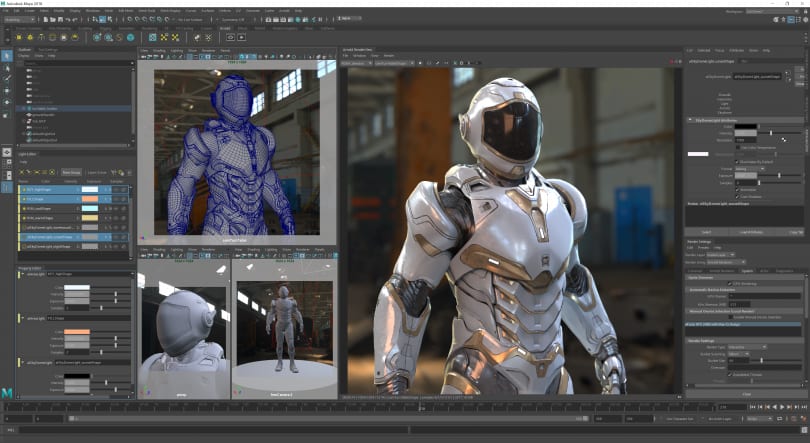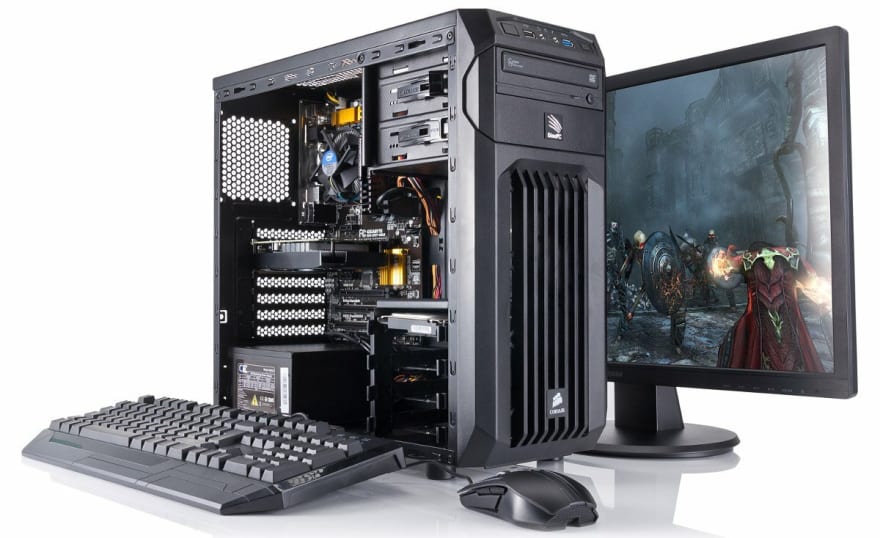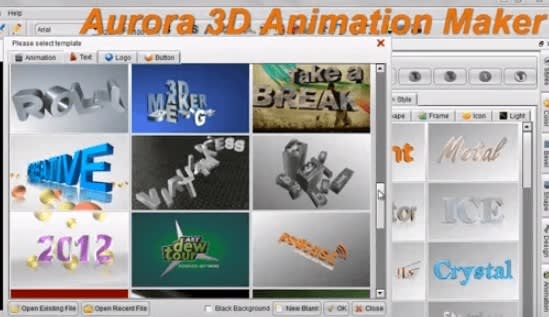What is Computer Animation?
So, what is computer animation? Computer animation is the branch of CGI (computer-generated imagery) that deals with the production of moving images. Including both 2-D and 3-D digital animations, computer animation makes possible the dazzling imagery and special effects that captivate audiences in blockbuster films such as Transformers, Lord of the Rings, and Avatar. The methods used in computer animation vary depending on the particular task, and range from manipulating a digital image rendered by a graphic artist, "keyframing" (replacing images with a slightly altered version of themselves, usually indicating a slight increase in time), or using motion capture to track a real-life actor or object and then digitally animating over top of them. The majority of the computer animation industry focuses on 3-D animation, favoring a mixture of the keyframing and motion capture techniques as industry-standard methods.

Computer animation: Digital heroes and computer-generated worlds
Computer animation is the art of creating moving images via the use of computers.
It is a subfield of computer graphics and animation.
Increasingly it is created by means of 3D computer graphics, though 2D computer graphics are still widely used for low bandwidth and faster real-time rendering needs.
Sometimes the target of the animation is the computer itself, but it sometimes the target is another medium, such as film.
It is also referred to as CGI (Computer-generated imagery or computer-generated imaging), especially when used in films.
To create the illusion of movement, an image is displayed on the computer screen then quickly replaced by a new image that is similar to the previous image, but shifted slightly.
This technique is identical to how the illusion of movement is achieved with television and motion pictures.
Computer animation is essentially a digital successor to the art of stop motion animation of 3D models and frame-by-frame animation of 2D illustrations.
For 3D animations, objects (models) are built on the computer monitor (modeled) and 3D figures are rigged with a virtual skeleton.
For 2D figure animations, separate objects (illustrations) and separate transparent layers are used, with or without a virtual skeleton.
Then the limbs, eyes, mouth, clothes, etc. of the figure are moved by the animator on key frames.
The differences in appearance between key frames are automatically calculated by the computer in a process known as tweening or morphing.
Finally, the animation is rendered.
For 3D animations, all frames must be rendered after modeling is complete.
For 2D vector animations, the rendering process is the key frame illustration process, while tweened frames are rendered as needed.
For pre-recorded presentations, the rendered frames are transferred to a different format or medium such as film or digital video.
The frames may also be rendered in real time as they are presented to the end-user audience.
Low bandwidth animations transmitted via the internet (e.g. 2D Flash, X3D) often use software on the end-users computer to render in real time as an alternative to streaming or pre-loaded high bandwidth animations.

Explanation
To trick the eye and brain into thinking they are seeing a smoothly moving object, the pictures should be drawn at around 12 frames per second or faster (a frame is one complete image). With rates above 70 frames/s no improvement in realism or smoothness is perceivable due to the way the eye and brain process images. At rates below 12 frames/s most people can detect jerkiness associated with the drawing of new images which detracts from the illusion of realistic movement. Conventional hand-drawn cartoon animation often uses 15 frames/s in order to save on the number of drawings needed, but this is usually accepted because of the stylized nature of cartoons. Because it produces more realistic imagery computer animation demands higher frame rates to reinforce this realism.
The reason no jerkiness is seen at higher speeds is due to "persistence of vision." From moment to moment, the eye and brain working together actually store whatever you look at for a fraction of a second, and automatically "smooth out" minor jumps. Movie film seen in a theater runs at 24 frames per second, which is sufficient to create this illusion of continuous movement. People are tricked into seeing the movement without any stoppage because the frames are shot at such a quick rate.
Computer animation is essentially a digital successor to the art of stop motion animation of 3D models and frame-by-frame animation of 2D illustrations. For 3D animations, objects (models) are created (modeled) on the computer monitor and 3D figures are rigged with a virtual skeleton. For 2D figure animations, separate objects (illustrations) and separate transparent layers are used, with or without a virtual skeleton. Then the figure's limbs, eyes, mouth, clothes, and so on are moved by the animator on key frames. The differences in appearance between key frames are automatically calculated by the computer, using a process known as tweening or morphing. Finally, the animation is rendered.
For 3D animations, all frames must be rendered after modeling is complete. For 2D vector animations, the rendering process is the key frame illustration process, while tweened frames are rendered as needed. For prerecorded presentations, the rendered frames are transferred to a different format or medium, such as film or digital video. The frames may also be rendered in real time as they are presented to the end-user audience. Low-bandwidth animations transmitted via the Internet (such as 2D Flash, X3D) often rely on software on the end-user's computer to render the animation in real time, as an alternative to streaming or pre-loaded, high-bandwidth animations.
- 3D COMPUTER GRAFICS SOFTWARE
3D computer graphics software refers to programs used to create 3D computer-generated imagery. 3D modelers are used in a wide variety of industries. The medical industry uses them to create detailed models of organs. The movie industry uses them to create and manipulate characters and objects for animated and real-life motion pictures. The video game industry uses them to create assets for video games. The science sector uses them to create highly detailed models of chemical compounds. The architecture industry uses them to create models of proposed buildings and landscapes. The engineering community uses them to design new devices, vehicles and structures as well as a host of other uses. There are typically many stages in the “pipeline” that studios and manufacturers use to create 3D objects for film, games, and production of hard goods and structures.
Many 3D modelers are general-purpose and can be used to produce models of various real-world entities, from plants to automobiles to people. Some are specially designed to model certain objects, such as chemical compounds or internal organs.
3D modelers allow users to create and alter models via their 3D mesh. Users can add, subtract, stretch and otherwise change the mesh to their desire. Models can be viewed from a variety of angles, usually simultaneously. Models can be rotated and the view can be zoomed in and out. 3D modelers can export their models to files, which can then be imported into other applications as long as the metadata is compatible. Many modelers allow importers and exporters to be plugged-in, so they can read and write data in the native formats of other applications.
Most 3D modelers contain a number of related features, such as ray tracers and other rendering alternatives and texture mapping facilities. Some also contain features that support or allow animation of models. Some may be able to generate full-motion video of a series of rendered scenes .

Computer animation development equipment
Computer animation can be created with a computer and animation software. Some impressive animation can be achieved even with basic programs; however the rendering can take a lot of time on an ordinary home computer. Because of this, video game animators tend to use low resolution, low polygon count renders, such that the graphics can be rendered in real time on a home computer. Photorealistic animation would be impractical in this context.
Professional animators of movies, television, and video sequences on computer games make photorealistic animation with high detail. This level of quality for movie animation would take tens to hundreds of years to create on a home computer. Many powerful workstation computers are used instead. Graphics workstation computers use two to four processors, and thus are a lot more powerful than a home computer, and are specialized for rendering. A large number of workstations (known as a render farm) are networked together to effectively act as a giant computer. The result is a computer-animated movie that can be completed in about one to five years . A workstation typically costs $2,000 to $16,000, with the more expensive stations being able to render much faster, due to the more technologically advanced hardware that they contain. Pixar’s Renderman is rendering software which is widely used as the movie animation industry standard, in competition with Mental Ray. It can be bought at the official Pixar website for about $3,500. It will work on Linux, Mac OS X, and Microsoft Windows based graphics workstations along with an animation program such as Maya and Softimage XSI. Professionals also use digital movie cameras, motion capture or performance capture, bluescreens, film editing software, props, and other tools for movie animation.

Major software packages
3ds Max (Autodesk), originally called 3D Studio MAX, is a comprehensive and versatile 3D application used in film, television, video games and architecture for Windows. It can be extended and customized through its SDK or scripting using a Maxscript. It can use third party rendering options such as Brazil R/S, finalRender and V-Ray.
Maya (Autodesk) is currently used in the film and television industry. Maya has developed over the years into an application platform in and of itself through extendability via its MEL programming language. It is available for Windows, Linux and Mac OS X.
Softimage (Autodesk) Softimage (formerly Softimage|XSI) is a 3D modeling and animation package that integrates with mental ray rendering. It is feature-similar to Maya and 3DS Max and is used in the production of professional films, commercials, video games, and other media.
LightWave 3D (NewTek), first developed for the Amiga, was originally bundled as part of the Video Toaster package and entered the market as a low cost way for TV production companies to create quality CGI for their programming. It first gained public attention with its use in the TV series Babylon 5 and is used in several contemporary TV series. Lightwave is also used in film production. It is available for both Windows and Mac OS X.
ZBrush (Pixologic) is a digital sculpting tool that combines 3D/2.5D modeling, texturing and painting tool available for Mac OS X and Windows. It is used to create normal maps for low resolution models to make them look more detailed.
Cinema 4D (MAXON) is a light package in its basic configuration. The software is for lay users. It has a lower initial entry cost due to a modular a-la-carte design for purchasing additional functions as users need them. Originally developed for the Amiga, it is also available for Mac OS X, Windows and Linux.

ANIMATION ALONG TIME
CGI was first used in movies in 1973’s Westworld, a science-fiction film about a society in which robots live and work among humans, though the first use of 3D Wireframe imagery was in its sequel, Futureworld (1976), which featured a computer-generated hand and face created by then University of Southern California graduate students Edwin Catmull and Fred Parke. The third movie to use this technology was Star Wars (1977) for the scenes with the wireframe Death Star plans and the targeting computers in the X-wings and the Millennium Falcon. The Black Hole (1979) used raster wire-frame model rendering to depict a black hole. The science fiction-horror film Alien of that same year also used a raster wire-frame model, in this case to render the image of navigation monitors in the sequence where a spaceship follows a beacon to a land on an unfamiliar planet.
In 1978, graduate students at the New York Institute of Technology Computer Graphics Lab began work on what would have been the first full-length CGI film, The Works, and a trailer for it was shown at SIGGRAPH 1982, but the film was never completed. Star Trek II: The Wrath of Khan premiered a short CGI sequence called The Genesis Wave in June 1982. The first two films to make heavy investments in Solid 3D CGI, Tron (1982) and The Last Starfighter (1984), were commercial failures, causing most directors to relegate CGI to images that were supposed to look like they were created by a computer.
It was the 1993 film Jurassic Park, however, in which dinosaurs created with CGI were seamlessly integrated into live action scenes, that revolutionized the movie industry. It marked Hollywood’s transition from stop-motion animation and conventional optical effects to digital techniques. The following year, CGI was used to create the special effects for Forrest Gump. The most noteworthy effects shots were those that featured the digital removal of actor Gary Sinise’s legs. Other effects included a napalm strike, the fast-moving Ping-Pong balls, and the digital insertion of Tom Hanks into several scenes of historical footage.
Two-dimensional CGI increasingly appeared in traditionally animated films, where it supplemented the use of hand-illustrated cels. Its uses ranged from digital tweening motion between frames, to eye-catching quasi-3D effects, such as the ballroom scene in Beauty and the Beast. In 1993, Babylon 5 became the first television series to use CGI as the primary method for its visual effects (rather than using hand-built models). It also marked the first TV use of virtual sets. That same year, Insektors became the first full-length completely computer animated TV series. Soon after, in 1994, the hit Canadian CGI show ReBoot aired.
Toy Story(1995) was the first fully computer-generated feature film.
In 1995, the first fully computer-generated feature film, Disney-Pixar’s Toy Story, was a resounding commercial success. Additional digital animation studios such as Blue Sky Studios (20th Century Fox), DNA Productions (Paramount Pictures and Warner Bros.), Omation Studios (Paramount Pictures), Sony Pictures Animation (Columbia Pictures), Vanguard Animation (Walt Disney Pictures, Lions Gate Entertainment and 20th Century Fox), Big Idea Productions (Universal Pictures and FHE Pictures), Animal Logic (Warner Bros.) and Pacific Data Images (Dreamworks SKG) went into production, and existing animation companies, such as The Walt Disney Company, began to make a transition from traditional animation to CGI. Between 1995 and 2005 the average effects budget for a wide-release feature film skyrocketed from $5 million to $40 million. According to one studio executive, as of 2005[update], more than half of feature films have significant effects. However, CGI has made up for the expenditures by grossing over 20% more than their real-life counterparts.
In the early 2000s, computer-generated imagery became the dominant form of special effects. The technology progressed to the point that it became possible to include virtual stunt doubles. Camera tracking software was refined to allow increasingly complex visual effects developments that were previously impossible. Computer-generated extras also became used extensively in crowd scenes with advanced flocking and crowd simulation software. Virtual sets, in which part or all of the background of a shot is digitally generated, also became commonplace. The timeline of CGI in film and television shows a detailed list of pioneering uses of computer-generated imagery in film and television.
CGI for films is usually rendered at about 1.4-6 megapixels. Toy Story, for example, was rendered at 1536 Ã- 922 (1.42MP). The time to render one frame is typically around 2-3 hours, with ten times that for the most complex scenes. This time hasn’t changed much in the last decade, as image quality has progressed at the same rate as improvements in hardware, since with faster machines, more and more complexity becomes feasible. Exponential increases in GPUs processing power, as well as massive increases in parallel CPU power, storage and memory speed and size have greatly increased CGI’s potential.
In 2001, Square Pictures created the CGI film Final Fantasy: The Spirits Within, which made headlines for attempting to create photo-realistic human actors. The film was not a box-office success. Some commentators have suggested this may be partly because the lead CGI characters had facial features which fell into the uncanny valley. Square Pictures produced only two more films using a similar visual style Final Flight of the Osiris, a short film which served as a prologue to The Matrix Reloaded and Final Fantasy VII: Advent Children, based on their extremely popular video game series.
Developments in CGI technologies are reported each year at SIGGRAPH, an annual conference on computer graphics and interactive techniques, attended each year by tens of thousands of computer professionals. Developers of computer games and 3D video cards strive to achieve the same visual quality on personal computers in real-time as is possible for CGI films and animation. With the rapid advancement of real-time rendering quality, artists began to use game engines to render non-interactive movies. This art form is called machinima.
This is a chronological list of films and television programs that have been recognised as being pioneering in their use of computer-generated imagery.

THE FUTURE OF ANIMATION
One open challenge in computer animation is a photorealistic animation of humans. Currently, most computer-animated movies show animal characters, fantasy characters, anthropomorphic machines or cartoon-like humans. The movie Final Fantasy: The Spirits Within is often cited as the first computer-generated movie to attempt to show realistic-looking humans. However, due to the enormous complexity of the human body, human motion, and human biomechanics, realistic simulation of humans remains largely an open problem. Another problem is the distasteful psychological response to viewing nearly perfect animation of humans, known as “the uncanny valley.” It is one of the “holy grails” of computer animation. Eventually, the goal is to create software where the animator can generate a movie sequence showing a photorealistic human character, undergoing physically-plausible motion, together with clothes, photorealistic hair, a complicated natural background, and possibly interacting with other simulated human characters. This could be done in a way that the viewer is no longer able to tell if a particular movie sequence is computer-generated, or created using real actors in front of movie cameras. Complete human realism is not likely to happen very soon, and when it does it may have major repercussions for the film industry.
For the moment it looks like three dimensional computer animation can be divided into two main directions; photorealistic and non-photorealistic rendering. Photorealistic computer animation can itself be divided into two subcategories; real photorealism (where performance capture is used in the creation of the virtual human characters) and stylized photorealism. Real photorealism is what Final Fantasy tried to achieve and will in the future most likely have the ability to give us live action fantasy features as The Dark Crystal without having to use advanced puppetry and animatronics, while Antz is an example on stylistic photorealism . None of them mentioned are perfected as of yet, but the progress continues.
The non-photorealistic/cartoonish direction is more like an extension of traditional animation, an attempt to make the animation look like a three dimensional version of a cartoon, still using and perfecting the main principles of animation articulated by the Nine Old Men, such as squash and stretch.
While a single frame from a photorealistic computer-animated feature will look like a photo if done right, a single frame vector from a cartoonish computer-animated feature will look like a painting (not to be confused with cel shading, which produces an even simpler look).








Top comments (0)